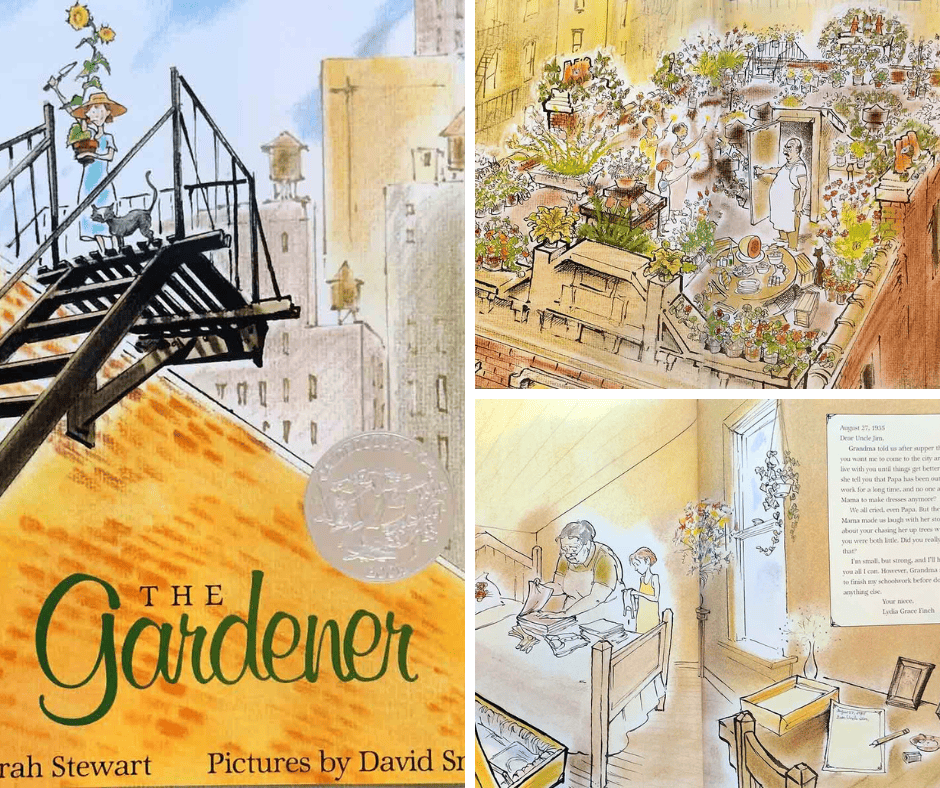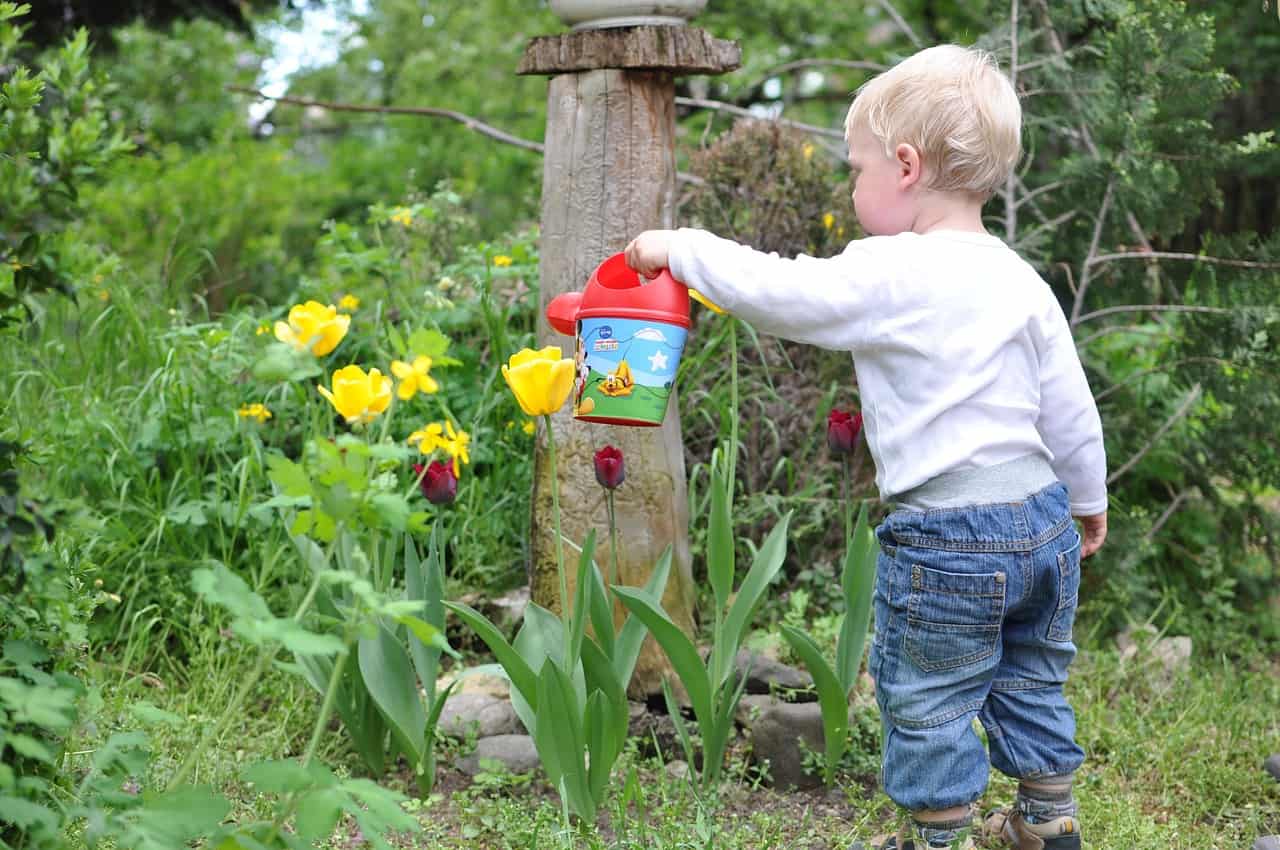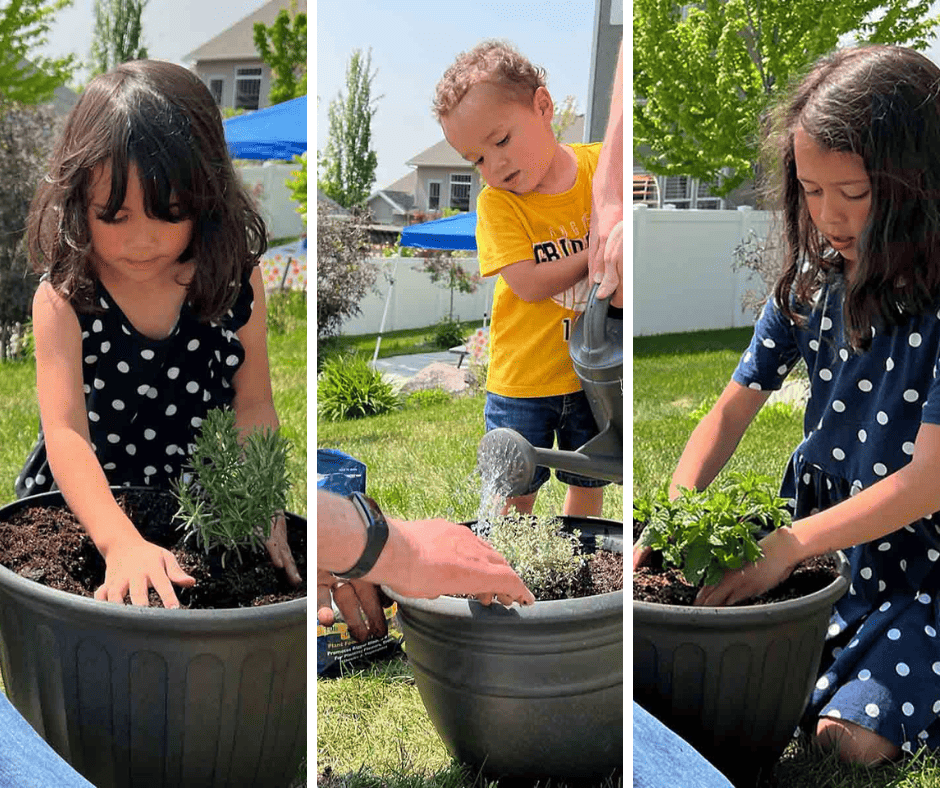Inside: Here are 7 ideas for creating memories with an herbal ancestor garden for kids and grandkids. It’s “emotional” gardening—the art of remembering your ancestors through a mutual connection to the soil. Planting herbal gardens, making medicinal teas, a gardener’s scrub, and more
Creating Memories Through an Ancestor Garden
The creature at your
feet dismissed as a
bug or a weed is a
creation in and of
itself. It has a name, a
million-year history,
and a place in the
world.
E.O. Wilson, The Future of Life
For the past 40+ years, my husband and I have planted vegetable gardens and fruit trees with our sons and now our grandkids.
While living in California, we grew lemon, orange, apricot, peach, and plum trees. We also grew all kinds of veggies—especially tomatoes that I canned each summer (a whopping 25 quarts each year).
There is something magical about getting your hands in dirt; planting seeds or starts; nurturing your garden and reaping the harvest. And miraculously, the harvest always comes!
Gardening is in my blood. It’s been passed down in my family for at least 12 generations. Planting a garden was the way my ancestors’ survived famines and hardships. They loved the earth first—I’m a byproduct of that love.
Remembering the Past Through an Ancestor Garden
Each year when gardening, I think of my ancestors —who nurtured and sustained their families through the land.
My grandmother, Elizabeth Schmidt Schutz was from Hessen, Germany. She had 10 siblings—2 died on the Somme and Verdun in WWI. To help her family survive, she was sent 200 miles away to work for a farmer and their family. Elizabeth was basically “farmed out” so her family could eat. She was only 7 years old. In her memoirs, she says she cried every night because she was so homesick. This experience made her strong but thinking of her loneliness makes me sad.
So, when I garden with my sons and grandkids, one of the people I think of is my grandmother Elizabeth.
The Gardener by Sarah Stewart
In 1997, the book, “The Gardener” by Sarah Stewart was published. The first time I read it, I fell in love with Lydia Grace (named after her grandmother). I felt it somewhat paralleled my grandmother Elizabeth’s story. It takes place during the 1935 Depression. She was sent to live with her gloomy Uncle Jim in the city until things improved at home just like my grandmother Elizabeth was sent away. Lydia Grace loves to grow things and travels by train to her uncle with her pockets and bags filled with seeds.
The book is about her experiences living in the city with her uncle, and transforming the roof of their apartment building into a beautiful flower garden.
Like Lydia Grace, my grandmother Elizabeth had a green thumb.
Emotional Gardening
Over the years, I’ve coined the phrase, “emotional gardening.” My definition: it’s planting a flower or vegetable garden or trees to remember and honor your ancestors. For me, it brings me emotionally closer to family members who gardened out of necessity and not as a hobby.
Here are 7 emotional ancestor gardening activities you can do to honor your ancestors as we honor ours who were blessed with green thumbs!
#1 Planting an Herbal Ancestor Garden with Your Kids & Grandkids
Before you begin planting, find out the zone you live in so that whatever you plant will grow in your particular climate. Click here to learn what planting zone you live in.
Many ancestors planted herb gardens and foraged for different weeds and flowers. Why? These early settlers used herbs, flowers, and weeds for medicinal purposes. Today, we know the healing power of herbs and weeds and their numerous health benefits. They can be used dried in tinctures and salves, fresh in teas and syrups, or in various dishes.
Here are some herbs to plant each year with your kids/grandkids. They are herbs our ancestors planted (and more than likely, yours did, too) and are wonderful to add to teas.
- Ginger Root: a powerful anti-inflammatory, healthier skin, and weight loss
- Turmeric: anti-inflammatory, arthritis, and digestive disorders, improves the immune system
- Mint: better brain function, boosts immune function, improves headaches
- Lemon Balm; promotes sleep & calm, and reduces stress & anxiety
- Oregano: reduces viral infections, high in antioxidants
- Sweet Basil; good for skin health, detoxes the body
#2 Making Herbal Teas from “What’s in the Garden?”
My great-grandmother, Victoria learned how to forage from the Native Americans. She took these “weeds” and plants and created medicinal tinctures, salves, and teas to help her family to stay well and to use when they got sick.
My grandmother Elizabeth concocted different “potions” made from herbs that she also used medicinally for her children and grandchildren.
Based on what I’ve read in their memoirs –I created a strong medicinal tea. Here is my recipe.
- 3 cups distilled water (distilled water is considered “hungry water” because it lacks minerals so the water is more efficient at drawing out the nutrients from the herbs
- 4 cinnamon sticks
- ⅓ cup fresh ginger, peeled & cut into slices
- 1 turmeric root, peeled; cut in fourths
- 3 whole cloves (optional—good for getting rid of mucus in the throat and lungs)
- Fresh mint from your garden
- Put everything in a glass mason jar
- Leave in the refrigerator overnight
- Put all the ingredients in a pot and bring to a boil. Lower heat and simmer for 20 minutes
- Turn off the heat, cover, and steep for 20 minutes
- Pour into 2 cups and let cool for 20 minutes to avoid burning your esophagus
- Drink.
#3 Arts and Crafts: Creating a Family Flower Garden
Here is a fun arts & crafts activity we did with our grandkids to remind them that “families” create a garden where members love and cherish one another.
Supplies
- Colored posterboard cut in half (14”x22”)
- Cupcake liners—different patterns, colors
- Pictures of different family members
- Paper handprint
- Pipe cleaners
- Tempera paints
Directions
- Using a balloon that is partially blown up, dip it in the tempera paints and press it onto the poster board. You will get an interesting texture for the background of your garden
- To create a paper flower, take 2-3 different cupcake liners and cut along the edges toward the circle in the middle creating petals. Stack the liners; glue in the center and cut around the edges so the liners are different widths exposing the other layers.
- Glue a pipe cleaner to the back for a stem
- Arrange your flowers on your posterboard, and glue them down.
- Take a picture of your family, print it out; glue it on the handprint, and cut it out.
- Glue the handprint family picture grasping the flower bunch.
#4 Make a Gardener’s Hand Scrub
 When working in the garden, your hands are apt to get dry and dirty. I’ve made many scrubs for the body, but this one is particularly good for a gardener’s hands that have grit and dirt in every pore and crevice. To give it a soothing boost—keep it in the refrigerator between uses.
When working in the garden, your hands are apt to get dry and dirty. I’ve made many scrubs for the body, but this one is particularly good for a gardener’s hands that have grit and dirt in every pore and crevice. To give it a soothing boost—keep it in the refrigerator between uses.
My ancestors used baking soda and borax—both are drying and harsh on the skin so I’ve updated to 21st-century ingredients—this gardener’s scrub cleans the hands without irritating the skin. You’ll find many other gardening scrubs that are similar.
Supplies
- ½ cup Epsom Salt—This is a pharmaceutical grade that will not irritate your skin
- 1 cup Dead Sea Salt (fine)
- 1/3-1/2 cup almond oil or coconut oil or apricot oil
- 1 Tablespoon Dr. Bronner’s liquid castile soap
- 10 drops cinnamon essential oil or Thieves essential oil (Young Living)
- 10 drops of lemon or orange essential oil
- Zest 1 lemon or one orange
- 1 Tablespoon ground ginger. Ginger is a powerful anti-inflammatory that soothes the skin
- 1 Tablespoon ground cloves or nutmeg
NOTE: You can interchange the salts and use 1 cup Epsom Salt and ½ cup Dead Sea Salt—I’ve done both
Directions
- In a bowl, combine all ingredients.
- Put in clear 4 oz. plastic jars—to prevent injuries with glass in the bathroom
- Makes three 4 oz. jars of scrub
#5 Painting Terra Cotta Planting Pots
Celebrate your ancestors, and create these colorful pots to grow herbs or flowers in.
Supplies
- Terra cotta pots
- Acrylic paints (watered down a bit)
- White paint sealer
- Clear acrylic paint sealer
- Flowers or herbs

After painting their pots, we lifted up the pot from the paper plate, and voila! A piece of art on the plate–see the picture far right on the bottom.
Directions
- Paint your pot with white sealer paint. Let dry
- Turn the pot upside down and squirt different colors of acrylic paint over the pot and down the sides—creating a drip-paint effect. You may need to put water in the paint to make it a bit more runny. Let dry.
- Seal with a clear seal to avoid paint chipping
- Plant a flower in your pot
#6 Who are Your Ancestors That Loved to Garden?
Did your ancestors plant gardens? Do you know what they planted? Do you garden each year to honor your ancestors and plant similar veggies, etc., that they did?
Here are a few “farmers” and gardeners in my family and what they planted.
My grandfather George Ernest Peck
He had a large garden filled with veggies and he sold his produce.
My father Max Peck
My father had a HUGE raspberry patch that produced lots of raspberries every summer. We ate them by the handfuls and made homemade raspberry ice cream.
My grandmother Elizabeth Schutz
She intermingled her flowers, herbs, veggies, and brambles into a large garden around the circumference of her home.
My great-grandmother Victoria Sandgren Harris
She foraged for weeds and grew herbal gardens for medicinal purposes. From her garden, she made teas, salves, and tinctures
#7 Books About Gardening for Children
Here are some wonderful children’s books to teach and inspire children about gardening
- The World that Feeds Us by Nancy Castaldo
- Let’s Get Gardening by DK
- The Gardener by Sarah Stewart
- Up in the Garden and Down in the Dirt by Kate Messner
- Trees, Leaves, Flowers and Seeds by DK Our World in Pictures
- From Seed to Plant by Gail Gibbons
- A Day at the Community Garden by Jannell Joosse
- The Companion Planting Soil Mates Guide by Christo Sullivan
Please share your gardening experiences in the comment section below
Want more information about gardening with your children or grandchildren? Check out this informative post: Gardening with Kids & Grandkids: 10 Simple and Amazing Steps

















Leave a Reply